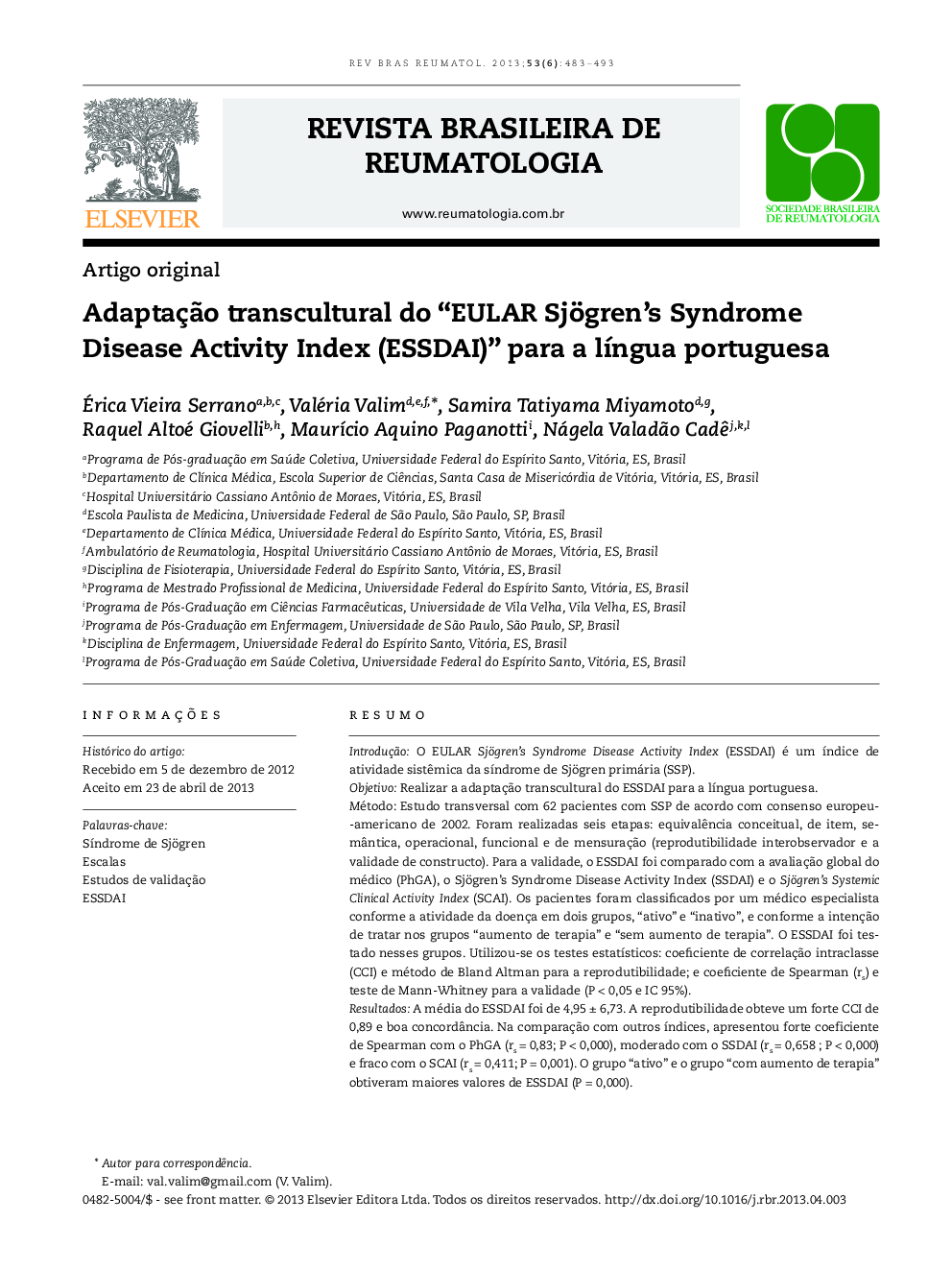| Article ID | Journal | Published Year | Pages | File Type |
|---|---|---|---|---|
| 3327093 | Revista Brasileira de Reumatologia | 2013 | 11 Pages |
ResumoIntroduçãoO EULAR Sjögren's Syndrome Disease Activity Index (ESSDAI) é um índice de atividade sistêmica da síndrome de Sjögren primária (SSP).ObjetivoRealizar a adaptação transcultural do ESSDAI para a língua portuguesa.MétodoEstudo transversal com 62 pacientes com SSP de acordo com consenso europeu-americano de 2002. Foram realizadas seis etapas: equivalência conceitual, de item, se- mântica, operacional, funcional e de mensuração (reprodutibilidade interobservador e a validade de constructo). Para a validade, o ESSDAI foi comparado com a avaliação global do médico (PhGA), o Sjögren's Syndrome Disease Activity Index (SSDAI) e o Sjögren's Systemic Clinical Activity Index (SCAI). Os pacientes foram classificados por um médico especialista conforme a atividade da doença em dois grupos, “ativo” e “inativo”, e conforme a intenção de tratar nos grupos “aumento de terapia” e “sem aumento de terapia”. O ESSDAI foi tes- tado nesses grupos. Utilizou-se os testes estatísticos: coeficiente de correlação intraclasse (CCI) e método de Bland Altman para a reprodutibilidade; e coeficiente de Spearman (rs) e teste de Mann-Whitney para a validade (P < 0,05 e IC 95%).ResultadosA média do ESSDAI foi de 4,95 ± 6,73. A reprodutibilidade obteve um forte CCI de 0,89 e boa concordância. Na comparação com outros índices, apresentou forte coeficiente de Spearman com o PhGA (rs = 0,83; P < 0,000), moderado com o SSDAI (rs = 0,658; P < 0,000) e fraco com o SCAI (rs = 0,411; P = 0,001). O grupo “ativo” e o grupo “com aumento de terapia” obtiveram maiores valores de ESSDAI (P = 0,000).Conclusãoa versão em português do ESSDAI mostrou ser adaptável, reprodutível e válida para a língua portuguesa.
IntroductionThe EULAR Sjögren's Syndrome Disease Activity Index (ESSDAI) is an index of primary Sjögren's syndrome (PSS) systemic activity.ObjectiveTo perform the ESSDAI transcultural adaptation into Brazilian Portuguese.MethodThis was a cross-sectional study with 62 patients with PSS according to the criteria of the 2002 American-European Consensus. Six stages were conducted: conceptual, item, semantic, operational, functional, and measurement equivalences (interobserver repro- ducibility and construct validity). For the validity assessment, the ESSDAI was compared with the Physician's Global Assessment (PhGA), the Sjögren's Syndrome Disease Activity Index (SSDAI), and the Sjögren's Systemic Clinical Activity Index (SCAI). Patients were clas- sified by a specialist physician into two groups according to disease activity (active and inactive), and according to the intention-to-treat (increase in therapy and no increase in therapy). The ESSDAI was tested in these groups. The following statistical tests were used: intraclass correlation coefficient (ICC), Bland-Altman plot for reproducibility, and Spear- man's correlation coefficient (rs) and Mann-Whitney's test for validity (P < 0.05 and 95% CI).ResultsThe mean ESSDAI score was 4.95 ± 6.73. The reproducibility obtained a strong ICC of 0.89 and good agreement. When compared with other indices, it showed a strong rs with PhGA (0.83; P < 0.000), a moderate rs with SSDAI (0.658; P < 0.000) and a weak rs with the SCAI (0.411; P = 0.001). The group “active” and the group “increase in therapy” had higher ESSDAI values (P = 0.000).ConclusionThe Brazilian Portuguese version of ESSDAI was shown to be adaptable, repro- ducible, and valid for this language.
